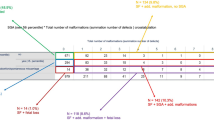Abstract
Purpose
In high-risk pregnancies, oligohydramnios is frequently used to identify fetuses at risk of an adverse outcome. The purpose of this study was to evaluate the effect of oligohydramnios on perinatal outcome in uncomplicated pregnancies between 40.0 and 41.6 weeks.
Methods
From January 1997 to December 2000 all uncomplicated pregnancies reaching 40.0 weeks' gestation with a singleton non-malformed fetus and reliable dating underwent monitoring with serial determination of amniotic fluid index (AFI) and biophysical profile. Labor was induced for AFI ≤5 cm, biophysical profile score of 6 or less, rise in maternal blood pressure >140/90 mm Hg, or gestational age of 42.0 weeks. Perinatal outcome was compared between cases with AFI ≤5 cm and those with AFI >5 cm using Chi-square or Fisher's exact test for categorical variables, Student's t-test for continuous variables, and logistic regression analysis. A two-tailed p value <0.05 or an odds ratio (OR) with 95% confidence interval (CI) not inclusive of the unity was considered significant.
Results
Three thousand and forty-nine women met the inclusion criteria, 341 of which (11%) had an AFI ≤5 cm. Gestational age at delivery, rates of nulliparity and induction of labor were significantly different between cases with oligohydramnios and those with normal AFI (all p<0.001). Rates of cesarean delivery for non-reassuring fetal testing (8.2% vs. 3.9%, p<0.001) and of neonates with birth weight <10th percentile (13.2% vs. 5.5%, p<0.001) were significantly higher in the AFI ≤5 cm group compared with the AFI >5 cm. No significant differences were identified between the two groups in rates of meconium-stained amniotic fluid, 5-min Apgar score <7, or umbilical artery pH <7. Logistic regression analysis demonstrated that the association between oligohydramnios and rate of cesarean delivery for non-reassuring fetal testing lost significance after controlling for gestational age at delivery, nulliparity and induction of labor, whereas the association between AFI ≤5 cm and low birth weight centiles remained statistically significant (OR=2.2, 95% CI 1.5, 3.2).
Conclusion
In conclusion, in uncomplicated pregnancies at 40.0 to 41.6 weeks, oligohydramnios is independently associated with a higher risk of low birth weight centile.
Similar content being viewed by others
References
Bar-Hava I, Divon M, Sardo M, Barnhard Y (1995) Fetus-placenta-newborn. Is oligohydramnios in postterm pregnancy associated with redistribution of fetal blood flow? Am J Obstet Gynecol 173:519–522
Chauhan SP, Sanderson M, Hendrix NW, Magann EF, Devoe LD (1999) Perinatal outcome and amniotic fluid index in the antepartum and intrapartum periods: a meta-analysis. Am J Obstet Gynecol 181:1473–1478
Clausson B, Cnattingius S, Axelsson O (1999) Outcomes of post-term births: the role of fetal growth restriction and malformations. Obstet Gynecol 94:758–762
Conway DL, Adkins WB, Schroeder B, Langer O (1998) Isolated oligohydramnios in the term pregnancy: is it a clinical entity? J Matern Fetal Med 7:197–200
Divon MY, Haglund B, Nisell H, Olausson Otterblad P, Westgren M (1998) Fetal and neonatal mortality in the postterm pregnancy: the impact of gestational age and fetal growth restriction. Am J Obstet Gynecol 178:726–731
Ghidini A, Spong C (2001) Severe meconium aspiration syndrome is not caused by aspiration of meconium. Am J Obstet Gynecol 185:931–938
Jeng CJ, Lee JF, Wang KG, Yang YC, Lan CC (1992) Decreased amniotic fluid index in term pregnancy: clinical significance. J Reprod Med 37:789–792
Magann EF, Chauhan SP, Kinsella MJ, McNamara MF, Whithworth NS, Morrison JC (1999) Antenatal testing among 1001 patients at high risk: the role of ultrasonographic estimate of amniotic fluid volume. Am J Obstet Gynecol 180:1330–1336
Phelan JP, Smith CV, Broussard P, Small M (1987) Amniotic fluid volume assessment using the four quadrant technique in pregnancy between 36 and 42 weeks' gestation. J Reprod Med 32:540–542
Robson SC, Crawford RA, Spencer JAD, Lee A (1992) Intrapartum amniotic fluid index and its relationship to fetal distress. Am J Obstet Gynecol 166:78–82
Rutherford SE, Phelan JP, Smith CV, Jacobs N (1987) The four-quadrant assessment of amniotic fluid volume: an adjunct to antepartum fetal heart rate testing. Obstet Gynecol 70:353–356
Sylvestre G, Divon MY (1999) The pathophysiology of amniotic fluid volume in the postterm pregnancy. Am J Obstet Gynecol 180:S23
Author information
Authors and Affiliations
Corresponding author
Rights and permissions
About this article
Cite this article
Locatelli, A., Vergani, P., Toso, L. et al. Perinatal outcome associated with oligohydramnios in uncomplicated term pregnancies. Arch Gynecol Obstet 269, 130–133 (2004). https://doi.org/10.1007/s00404-003-0525-6
Received:
Accepted:
Published:
Issue Date:
DOI: https://doi.org/10.1007/s00404-003-0525-6




